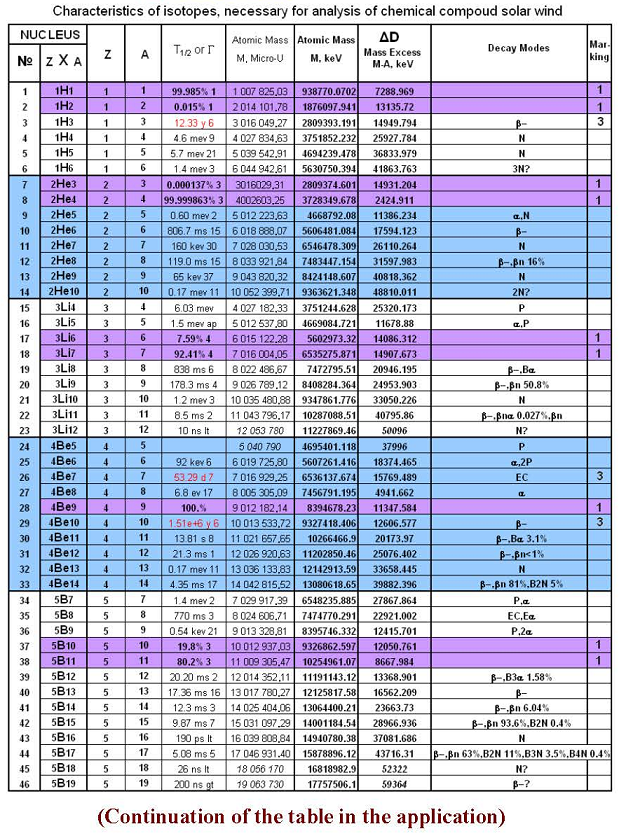1. The factors influencing the chemical compound of «a solar wind».
— In order to include any kernel in the structure of «solar wind», there should be the probability of manufacture this kernel in the process of synthesis in «the active zone», or in the nutria of a star. For this purpose it is necessary that for the speed of the initial kernels participated in the synthesis were sufficient for the synthesis of the kernel we’re interested in.
— The speed of the received kernel should be more than zero.
— The speed of the received kernel should be sufficient for overcoming the resistance of a star (magnetic, gravitational fields, f(v, Mz, mz, z))
— The stability of the received kernel. Time of a kernel life, received during the synthesis should be enough for recognition of this kernel. Since from the birth of the atom kernel until its recognition passes the time period, during which the kernel is taken up to the space vehicle, for gathering particles of «a solar wind» enters, the time of delivery to the laboratory and the analysis. Hence, stability and time of a life of isotopes of «a solar wind» influences the reliability of definition of the chemical compound of «the solar wind».
In the table №A-2, presented the data about time of a life of isotopes up to z=30.
(65) Table №A-2
2. The factors influencing the speed, energy and temperature of particles and kernels that are a part of the solar wind.
In the process of kernels synthesis the energy and the weight is being allocated or absorbed.
During the participation in synthesis of easy kernels, in most cases energy is allocated. The kernel received as a result of such synthesis will have the impulse and the speed received during the energy allocation. The speed, energy and temperature of the kernel received during the moment of synthesis depend on the energy allocated during this synthesis. At the process of different nuclear reactions, different quantity of energy is allocated or absorbed. Hence, each reaction is characterized by the parameters of speed, energy and the temperature, distinct from other reactions. At the reception of identical isotopes, as a result of different reactions, parameters of speed, energy and temperature of the received isotopes will be different.
How «the solar wind» is born?
If we’d start with the operating theory of the Sun structure, the isotope structure of the «solar wind» should consist only from hydrogen and helium kernels. Since hydrogen and helium are the most easy elements, also they are located they in the uppermost layers of the Sun atmosphere. Heavier kernels ions and atoms could not make the way constantly through the atmosphere of a star. If to compare the chemical compounds of «the solar wind» and the Sun, we shall see, that in the chemical compound of the Sun, the elements of the periodic table are all included, up to the uranium. In the chemical compound of the solar wind, only isotopes of the first 28-30 elements enter. The data of atoms isotopes entering into the chemical compound of «the solar wind» are resulted in the table №A-2 (in the application).
At first sight, the difference between the chemical compounds of the Sun and «the solar wind» is not of a great importance. But for the physicist-nuclear physicistthis fact speaks in favor of the origin of «the solar wind». So, in the process of kernels synthesis, on a chain from hydrogen +1H with A=1 up to heavy transuranium elements, with increase in nuclear number, the allocation of energy decreases. Synthesis of kernels of atoms with z> 30 occurs with small allocation of energy, insufficient for them to be a part of «the solar wind». In the process of synthesis of heavier kernels, the energy is not allocated, but absorbed, so these kernels do not receive the impulses which allow them to be a part of «the solar wind» (although the probability of their occurrence in structure of «the solar wind» still exists).
In the process of synthesis, the new kernel receives an impulse proportional to the allocated energy. The energy is allocated through the radiation on the one hand and through an impulse received by the kernel, on the other.
Let’s move to the analysis of «the solar wind» from the position of our theory, when the synthesis of easy kernels, with allocation of most of the energy processes in volume, which we have named «the ACTIVE ZONE».
If we analyze closely the table №A-2, and the isotope structure of «the solar wind», we shall receive answers to many questions.
That way, the stable isotopes enter the chemical compound of «the solar wind», mostly. But at the moment of synthesis of kernels unstable isotopes should be formed as well. Where are they?
According to table №A-2, most of the unstable isotopes from hydrogen up to zinc have short time of life. At the time of radiation and up to the analysis of tests of «the solar wind» these kernels break up, occurring in a stable state. Hence, the detection of unstable isotopes in «the solar wind» proves that the synthesis of kernels in star occurs in «the active zone», instead of in its center, and the chemical compound of a star varies, as a result of the synthesis of kernels in the top layers of the star atmosphere, and not due to enter of these kernels into the structure of the star from other sources.
It is practically impossible to get into the structure of the solar wind from a kernel of a star, during the life of an unstable isotope.
Since the time of life of the given isotope, should suffice for its analysis and identification.
Than shorter the time interval between the birth of an isotope and its analysis, and the closer to a star will be a sample taken, the higher will be the isotope in the structure of «solar wind».


